Margin of Appreciation Doctrine in European Human Rights Law
VerifiedAdded on 2023/04/25
|16
|4277
|477
AI Summary
This study critically analyzes the margin of appreciation doctrine in European Human Rights Law and its impact on the effectiveness of the European Convention on Human Rights. It covers the concept, justification, and analysis of the doctrine and its impact on the role of the European Court of Human Rights.
Contribute Materials
Your contribution can guide someone’s learning journey. Share your
documents today.

Summative Assignment
LW223-5-FY
European Human Rights Law
LW223-5-FY
European Human Rights Law
Secure Best Marks with AI Grader
Need help grading? Try our AI Grader for instant feedback on your assignments.
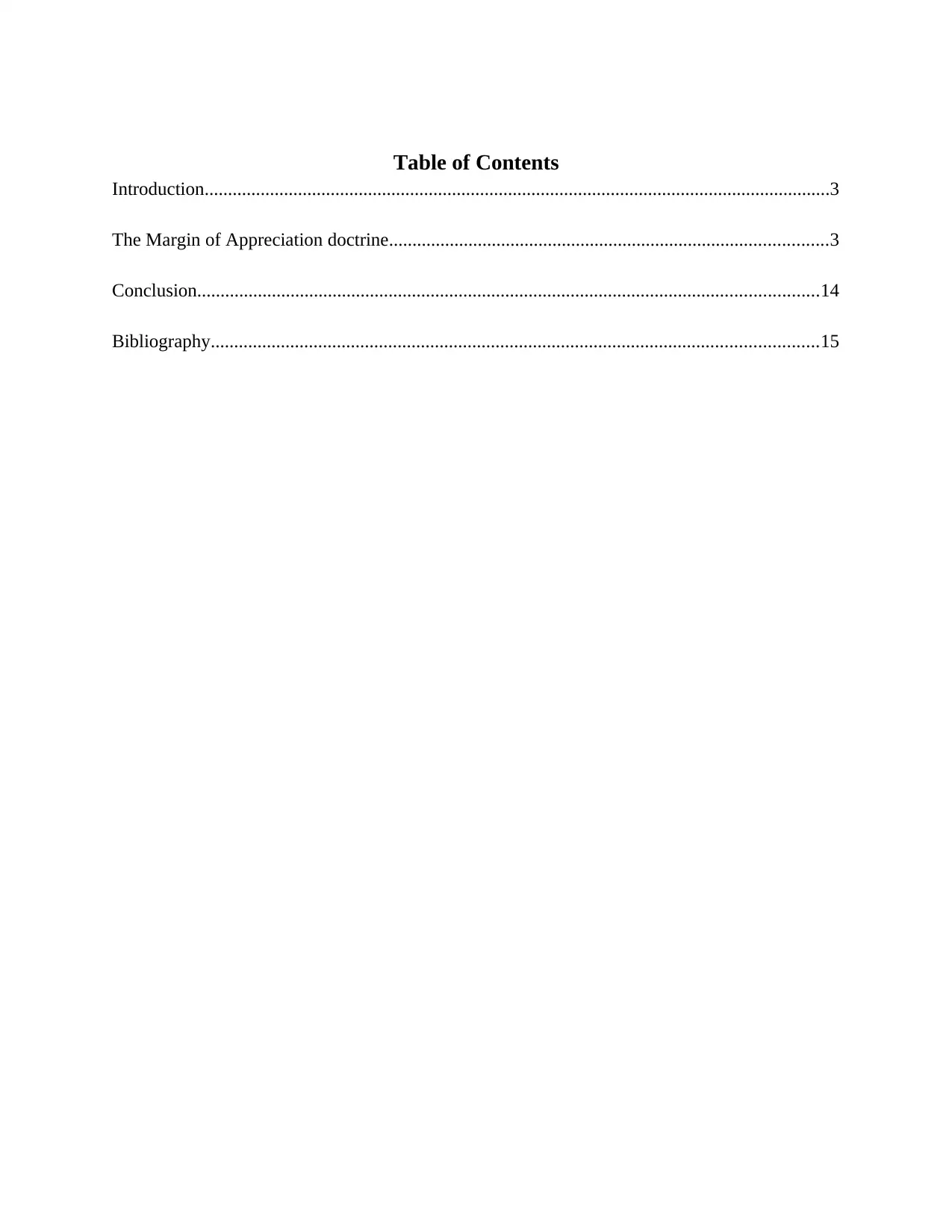
Table of Contents
Introduction......................................................................................................................................3
The Margin of Appreciation doctrine..............................................................................................3
Conclusion.....................................................................................................................................14
Bibliography..................................................................................................................................15
Introduction......................................................................................................................................3
The Margin of Appreciation doctrine..............................................................................................3
Conclusion.....................................................................................................................................14
Bibliography..................................................................................................................................15
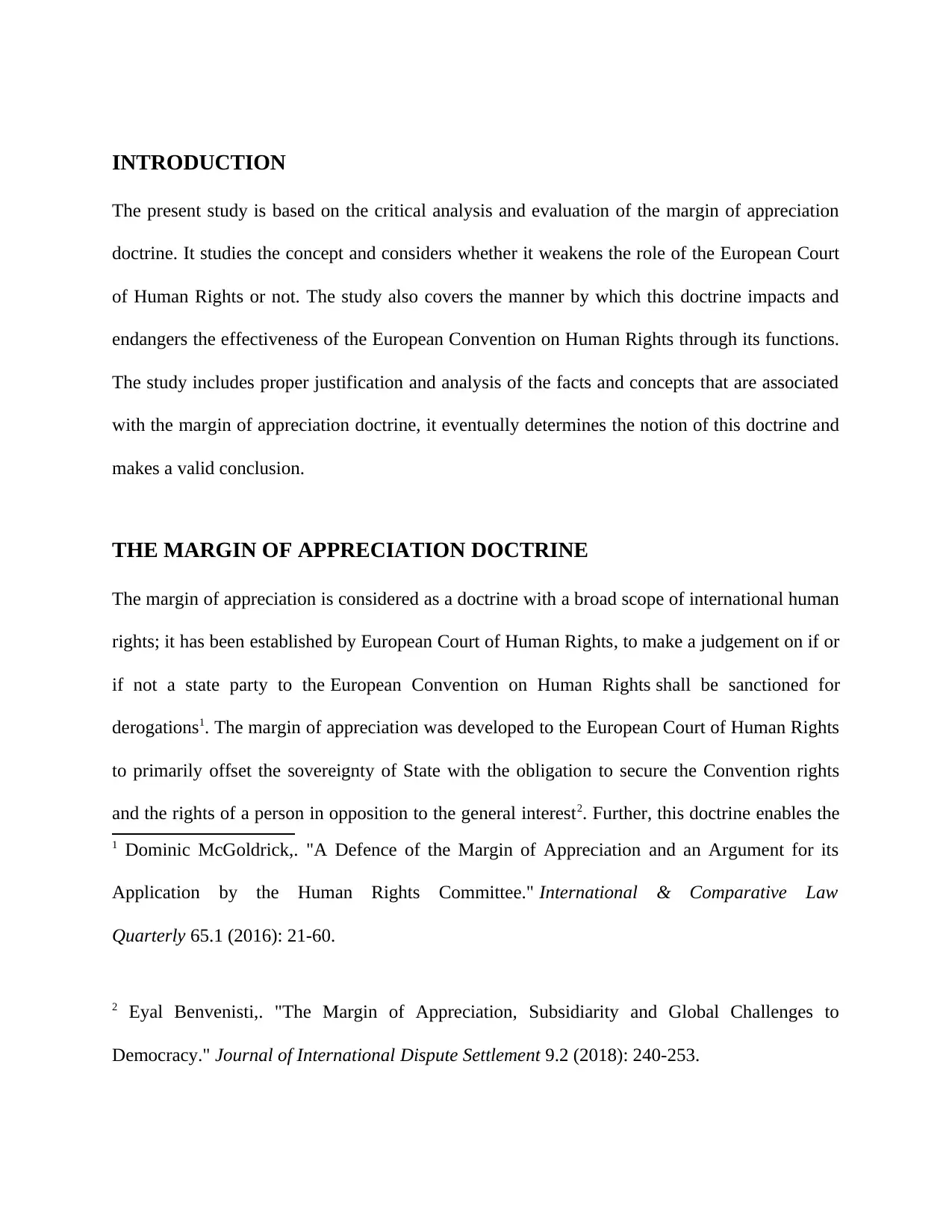
INTRODUCTION
The present study is based on the critical analysis and evaluation of the margin of appreciation
doctrine. It studies the concept and considers whether it weakens the role of the European Court
of Human Rights or not. The study also covers the manner by which this doctrine impacts and
endangers the effectiveness of the European Convention on Human Rights through its functions.
The study includes proper justification and analysis of the facts and concepts that are associated
with the margin of appreciation doctrine, it eventually determines the notion of this doctrine and
makes a valid conclusion.
THE MARGIN OF APPRECIATION DOCTRINE
The margin of appreciation is considered as a doctrine with a broad scope of international human
rights; it has been established by European Court of Human Rights, to make a judgement on if or
if not a state party to the European Convention on Human Rights shall be sanctioned for
derogations1. The margin of appreciation was developed to the European Court of Human Rights
to primarily offset the sovereignty of State with the obligation to secure the Convention rights
and the rights of a person in opposition to the general interest2. Further, this doctrine enables the
1 Dominic McGoldrick,. "A Defence of the Margin of Appreciation and an Argument for its
Application by the Human Rights Committee." International & Comparative Law
Quarterly 65.1 (2016): 21-60.
2 Eyal Benvenisti,. "The Margin of Appreciation, Subsidiarity and Global Challenges to
Democracy." Journal of International Dispute Settlement 9.2 (2018): 240-253.
The present study is based on the critical analysis and evaluation of the margin of appreciation
doctrine. It studies the concept and considers whether it weakens the role of the European Court
of Human Rights or not. The study also covers the manner by which this doctrine impacts and
endangers the effectiveness of the European Convention on Human Rights through its functions.
The study includes proper justification and analysis of the facts and concepts that are associated
with the margin of appreciation doctrine, it eventually determines the notion of this doctrine and
makes a valid conclusion.
THE MARGIN OF APPRECIATION DOCTRINE
The margin of appreciation is considered as a doctrine with a broad scope of international human
rights; it has been established by European Court of Human Rights, to make a judgement on if or
if not a state party to the European Convention on Human Rights shall be sanctioned for
derogations1. The margin of appreciation was developed to the European Court of Human Rights
to primarily offset the sovereignty of State with the obligation to secure the Convention rights
and the rights of a person in opposition to the general interest2. Further, this doctrine enables the
1 Dominic McGoldrick,. "A Defence of the Margin of Appreciation and an Argument for its
Application by the Human Rights Committee." International & Comparative Law
Quarterly 65.1 (2016): 21-60.
2 Eyal Benvenisti,. "The Margin of Appreciation, Subsidiarity and Global Challenges to
Democracy." Journal of International Dispute Settlement 9.2 (2018): 240-253.
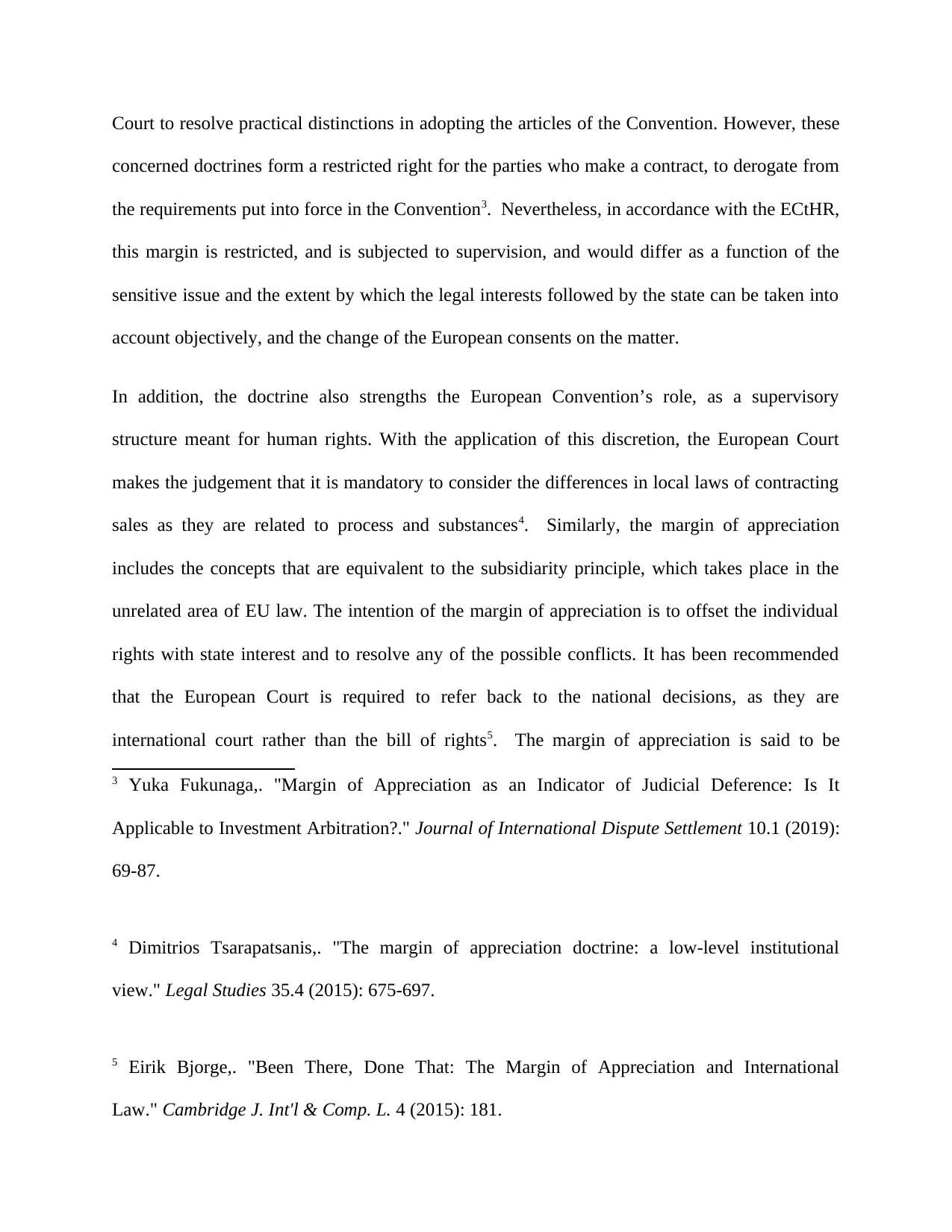
Court to resolve practical distinctions in adopting the articles of the Convention. However, these
concerned doctrines form a restricted right for the parties who make a contract, to derogate from
the requirements put into force in the Convention3. Nevertheless, in accordance with the ECtHR,
this margin is restricted, and is subjected to supervision, and would differ as a function of the
sensitive issue and the extent by which the legal interests followed by the state can be taken into
account objectively, and the change of the European consents on the matter.
In addition, the doctrine also strengths the European Convention’s role, as a supervisory
structure meant for human rights. With the application of this discretion, the European Court
makes the judgement that it is mandatory to consider the differences in local laws of contracting
sales as they are related to process and substances4. Similarly, the margin of appreciation
includes the concepts that are equivalent to the subsidiarity principle, which takes place in the
unrelated area of EU law. The intention of the margin of appreciation is to offset the individual
rights with state interest and to resolve any of the possible conflicts. It has been recommended
that the European Court is required to refer back to the national decisions, as they are
international court rather than the bill of rights5. The margin of appreciation is said to be
3 Yuka Fukunaga,. "Margin of Appreciation as an Indicator of Judicial Deference: Is It
Applicable to Investment Arbitration?." Journal of International Dispute Settlement 10.1 (2019):
69-87.
4 Dimitrios Tsarapatsanis,. "The margin of appreciation doctrine: a low-level institutional
view." Legal Studies 35.4 (2015): 675-697.
5 Eirik Bjorge,. "Been There, Done That: The Margin of Appreciation and International
Law." Cambridge J. Int'l & Comp. L. 4 (2015): 181.
concerned doctrines form a restricted right for the parties who make a contract, to derogate from
the requirements put into force in the Convention3. Nevertheless, in accordance with the ECtHR,
this margin is restricted, and is subjected to supervision, and would differ as a function of the
sensitive issue and the extent by which the legal interests followed by the state can be taken into
account objectively, and the change of the European consents on the matter.
In addition, the doctrine also strengths the European Convention’s role, as a supervisory
structure meant for human rights. With the application of this discretion, the European Court
makes the judgement that it is mandatory to consider the differences in local laws of contracting
sales as they are related to process and substances4. Similarly, the margin of appreciation
includes the concepts that are equivalent to the subsidiarity principle, which takes place in the
unrelated area of EU law. The intention of the margin of appreciation is to offset the individual
rights with state interest and to resolve any of the possible conflicts. It has been recommended
that the European Court is required to refer back to the national decisions, as they are
international court rather than the bill of rights5. The margin of appreciation is said to be
3 Yuka Fukunaga,. "Margin of Appreciation as an Indicator of Judicial Deference: Is It
Applicable to Investment Arbitration?." Journal of International Dispute Settlement 10.1 (2019):
69-87.
4 Dimitrios Tsarapatsanis,. "The margin of appreciation doctrine: a low-level institutional
view." Legal Studies 35.4 (2015): 675-697.
5 Eirik Bjorge,. "Been There, Done That: The Margin of Appreciation and International
Law." Cambridge J. Int'l & Comp. L. 4 (2015): 181.
Secure Best Marks with AI Grader
Need help grading? Try our AI Grader for instant feedback on your assignments.

doctrine, wherein the European Court of Human Rights calls upon its understanding of the
European Convention based on Fundamental Freedoms as well as Human Rights. It is an
interpretation method that the court based on Strasbourg makes use of it in a habituate manner.
With a differing extent, the doctrine enables for varying interpretation of the principle by the
member states of the Council of Europe6. The margin of appreciation doctrine might also
weaken, but not disprove, an argument in opposition to the judicial review. Further, the doctrine,
cautiously specified and constantly applied, makes reduction of the risk of the states that are
subjected to the discretion of the judges of the ECtHR. On the other hand, the margin of
appreciation generally lacks a precise outcome in regards with the Convention standard, (the
outcomes is a weakening force of the constitutional) position of the Court as per the Convention
system. The implementation and interpretation of the international human right convention is
particularly a sensitive task. Yet the international courts have the authority of interpretation,
within their area of competence, the characteristic of safeguarding human rights in opposition to
the potential state interferences, the practice of their jurisdictional role is not possible in the
absence of a continuous reconciliation of values and components that might be an issue to be
considered7. In this way, these courts practise great skills for the accommodation of the
6 Fabio Macioce,. "Cultural Rights and the Margin of Appreciation Doctrine: A Legal Tool for
Balancing Individual Rights and Traditional Rules." Law, Culture and the Humanities 13.3
(2017): 446-468.
7 Andreas Fóllesdal,. "Subsidiarity and International Human-Rights Courts: Respecting Self-
Governance and Protecting Human Rights-Or Neither." Law & Contemp. Probs. 79 (2016): 147.
European Convention based on Fundamental Freedoms as well as Human Rights. It is an
interpretation method that the court based on Strasbourg makes use of it in a habituate manner.
With a differing extent, the doctrine enables for varying interpretation of the principle by the
member states of the Council of Europe6. The margin of appreciation doctrine might also
weaken, but not disprove, an argument in opposition to the judicial review. Further, the doctrine,
cautiously specified and constantly applied, makes reduction of the risk of the states that are
subjected to the discretion of the judges of the ECtHR. On the other hand, the margin of
appreciation generally lacks a precise outcome in regards with the Convention standard, (the
outcomes is a weakening force of the constitutional) position of the Court as per the Convention
system. The implementation and interpretation of the international human right convention is
particularly a sensitive task. Yet the international courts have the authority of interpretation,
within their area of competence, the characteristic of safeguarding human rights in opposition to
the potential state interferences, the practice of their jurisdictional role is not possible in the
absence of a continuous reconciliation of values and components that might be an issue to be
considered7. In this way, these courts practise great skills for the accommodation of the
6 Fabio Macioce,. "Cultural Rights and the Margin of Appreciation Doctrine: A Legal Tool for
Balancing Individual Rights and Traditional Rules." Law, Culture and the Humanities 13.3
(2017): 446-468.
7 Andreas Fóllesdal,. "Subsidiarity and International Human-Rights Courts: Respecting Self-
Governance and Protecting Human Rights-Or Neither." Law & Contemp. Probs. 79 (2016): 147.

expectations of the citizens of the right protection, and concern of democratic in a social setting
that is evolving and the will of the states.
The margin of appreciation doctrine has been under criticism as an interpretive mechanism for
making it highly complicated to simplify the legal answers made by Court, for hassling structural
incoherence, and endangering legal conviction while avoiding the Convention from securing
consistent rights protection system in the region.
The doctrine of the margin of appreciation is based on the aspect that every society is authorized
to some latitude in resolving the conflicts held among individual rights and state interest or
between various moral convictions. This particular doctrine that has been formed by the
European Convention on Human Rights and the organizations responsible for the developed laws
provides an opportunity to the State Parties to the Convention to put a balance among the societal
good and the individual rights when they limit laws. Furthermore, this underlying rule is that the
state authorities have good positions as compared to the international judge to make decisions on
the appropriate application of the of the Convention to explicit contexts. The establishment of
this theory is significant to consider as Turkey agree to the EU and comes into force to comply
with European standards. The provision makes sure that the higher level and most favourable
human rights ensure in the national law of State Parties are not be referenced by the less efficient
provisions of the ECHR. Thus, it is apparent that the ECHR is neither purposed to make
replacement of local guarantees not to offer security for rights and basic freedoms by the ECHR
guarantees merely. Overall, the conventions make effective protection and do respect for the
means of the national laws8. Therefore, it can be said that the use of the margin appreciation
8 Anna Gunn,, and Luts Joris. "Tax Rulings, APAs and State Aid: Legal Issue." EC Tax
Review 24.2 (2015): 119-125.
that is evolving and the will of the states.
The margin of appreciation doctrine has been under criticism as an interpretive mechanism for
making it highly complicated to simplify the legal answers made by Court, for hassling structural
incoherence, and endangering legal conviction while avoiding the Convention from securing
consistent rights protection system in the region.
The doctrine of the margin of appreciation is based on the aspect that every society is authorized
to some latitude in resolving the conflicts held among individual rights and state interest or
between various moral convictions. This particular doctrine that has been formed by the
European Convention on Human Rights and the organizations responsible for the developed laws
provides an opportunity to the State Parties to the Convention to put a balance among the societal
good and the individual rights when they limit laws. Furthermore, this underlying rule is that the
state authorities have good positions as compared to the international judge to make decisions on
the appropriate application of the of the Convention to explicit contexts. The establishment of
this theory is significant to consider as Turkey agree to the EU and comes into force to comply
with European standards. The provision makes sure that the higher level and most favourable
human rights ensure in the national law of State Parties are not be referenced by the less efficient
provisions of the ECHR. Thus, it is apparent that the ECHR is neither purposed to make
replacement of local guarantees not to offer security for rights and basic freedoms by the ECHR
guarantees merely. Overall, the conventions make effective protection and do respect for the
means of the national laws8. Therefore, it can be said that the use of the margin appreciation
8 Anna Gunn,, and Luts Joris. "Tax Rulings, APAs and State Aid: Legal Issue." EC Tax
Review 24.2 (2015): 119-125.

doctrine and its effects are generally unpredictable, leading to a questioning of the Court and a
reformed reflection of the Court’s role vis-à-vis the Member States of the European Convention.
Ultimately, the margin of appreciation doctrine can offer international courts with more
flexibility for a longer period monitoring of national actors, it allows international courts to make
criticism on states with no articulation of the illegality of their conduct, and to urge national
actors to make improvement in their performance record9. Further, such improvements can
eventually weaken resistance to judicial supervisory and ease the long-run internalization of
international value and rules, as occurred in Europe in relation to the ECtHR case law. With the
consideration towards such aspects, these are sometimes mentioned as ‘judicial politics’, an
individual can sustain that comity stands for judicious politics10.
One more concern is coping up with the implementation of a common margin of appreciation
doctrine is the perspective that the state authorities decide on the application of the international
law in support of overriding national interests and the extent to which they can be said as
trustworthy with the practice of discretion in regards to the way of application of international
rules is in doubt11. However, this gap in exercise among both national actors as well as
9 Patricia Popelier,, and Heyning Catherine Van de. "Subsidiarity Post-Brighton: Procedural
Rationality as Answer?." Leiden Journal of International Law 30.1 (2017): 5-23.
10 García Oliva, Javier. "Religious Dress Codes in the United Kingdom." Religion in Public
Spaces: A European Perspective(2016): 217.
11 Markus Jachtenfuchs,, and Krisch Nico. "Subsidiarity in global governance." Law & Contemp.
Probs. 79 (2016): 1.
reformed reflection of the Court’s role vis-à-vis the Member States of the European Convention.
Ultimately, the margin of appreciation doctrine can offer international courts with more
flexibility for a longer period monitoring of national actors, it allows international courts to make
criticism on states with no articulation of the illegality of their conduct, and to urge national
actors to make improvement in their performance record9. Further, such improvements can
eventually weaken resistance to judicial supervisory and ease the long-run internalization of
international value and rules, as occurred in Europe in relation to the ECtHR case law. With the
consideration towards such aspects, these are sometimes mentioned as ‘judicial politics’, an
individual can sustain that comity stands for judicious politics10.
One more concern is coping up with the implementation of a common margin of appreciation
doctrine is the perspective that the state authorities decide on the application of the international
law in support of overriding national interests and the extent to which they can be said as
trustworthy with the practice of discretion in regards to the way of application of international
rules is in doubt11. However, this gap in exercise among both national actors as well as
9 Patricia Popelier,, and Heyning Catherine Van de. "Subsidiarity Post-Brighton: Procedural
Rationality as Answer?." Leiden Journal of International Law 30.1 (2017): 5-23.
10 García Oliva, Javier. "Religious Dress Codes in the United Kingdom." Religion in Public
Spaces: A European Perspective(2016): 217.
11 Markus Jachtenfuchs,, and Krisch Nico. "Subsidiarity in global governance." Law & Contemp.
Probs. 79 (2016): 1.
Paraphrase This Document
Need a fresh take? Get an instant paraphrase of this document with our AI Paraphraser
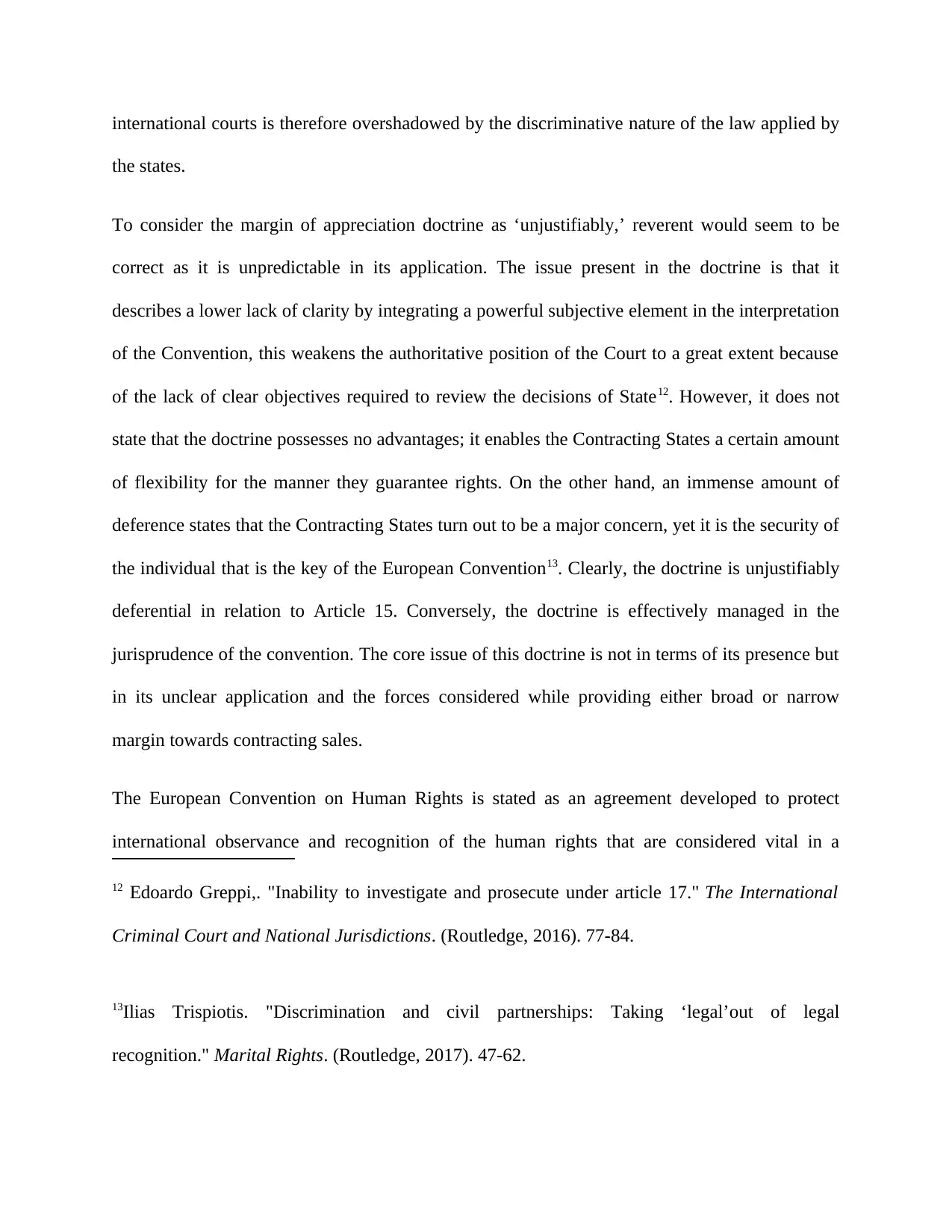
international courts is therefore overshadowed by the discriminative nature of the law applied by
the states.
To consider the margin of appreciation doctrine as ‘unjustifiably,’ reverent would seem to be
correct as it is unpredictable in its application. The issue present in the doctrine is that it
describes a lower lack of clarity by integrating a powerful subjective element in the interpretation
of the Convention, this weakens the authoritative position of the Court to a great extent because
of the lack of clear objectives required to review the decisions of State12. However, it does not
state that the doctrine possesses no advantages; it enables the Contracting States a certain amount
of flexibility for the manner they guarantee rights. On the other hand, an immense amount of
deference states that the Contracting States turn out to be a major concern, yet it is the security of
the individual that is the key of the European Convention13. Clearly, the doctrine is unjustifiably
deferential in relation to Article 15. Conversely, the doctrine is effectively managed in the
jurisprudence of the convention. The core issue of this doctrine is not in terms of its presence but
in its unclear application and the forces considered while providing either broad or narrow
margin towards contracting sales.
The European Convention on Human Rights is stated as an agreement developed to protect
international observance and recognition of the human rights that are considered vital in a
12 Edoardo Greppi,. "Inability to investigate and prosecute under article 17." The International
Criminal Court and National Jurisdictions. (Routledge, 2016). 77-84.
13Ilias Trispiotis. "Discrimination and civil partnerships: Taking ‘legal’out of legal
recognition." Marital Rights. (Routledge, 2017). 47-62.
the states.
To consider the margin of appreciation doctrine as ‘unjustifiably,’ reverent would seem to be
correct as it is unpredictable in its application. The issue present in the doctrine is that it
describes a lower lack of clarity by integrating a powerful subjective element in the interpretation
of the Convention, this weakens the authoritative position of the Court to a great extent because
of the lack of clear objectives required to review the decisions of State12. However, it does not
state that the doctrine possesses no advantages; it enables the Contracting States a certain amount
of flexibility for the manner they guarantee rights. On the other hand, an immense amount of
deference states that the Contracting States turn out to be a major concern, yet it is the security of
the individual that is the key of the European Convention13. Clearly, the doctrine is unjustifiably
deferential in relation to Article 15. Conversely, the doctrine is effectively managed in the
jurisprudence of the convention. The core issue of this doctrine is not in terms of its presence but
in its unclear application and the forces considered while providing either broad or narrow
margin towards contracting sales.
The European Convention on Human Rights is stated as an agreement developed to protect
international observance and recognition of the human rights that are considered vital in a
12 Edoardo Greppi,. "Inability to investigate and prosecute under article 17." The International
Criminal Court and National Jurisdictions. (Routledge, 2016). 77-84.
13Ilias Trispiotis. "Discrimination and civil partnerships: Taking ‘legal’out of legal
recognition." Marital Rights. (Routledge, 2017). 47-62.
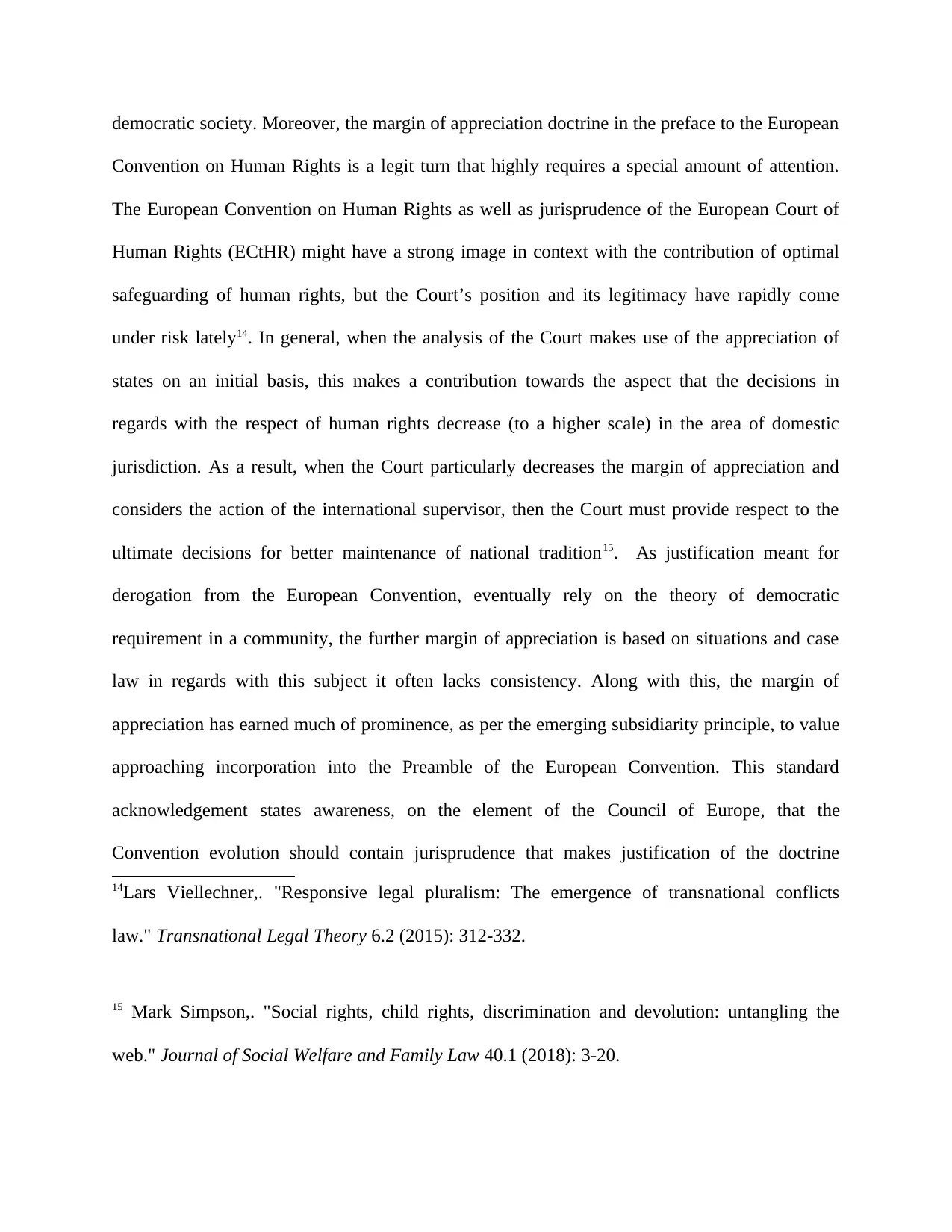
democratic society. Moreover, the margin of appreciation doctrine in the preface to the European
Convention on Human Rights is a legit turn that highly requires a special amount of attention.
The European Convention on Human Rights as well as jurisprudence of the European Court of
Human Rights (ECtHR) might have a strong image in context with the contribution of optimal
safeguarding of human rights, but the Court’s position and its legitimacy have rapidly come
under risk lately14. In general, when the analysis of the Court makes use of the appreciation of
states on an initial basis, this makes a contribution towards the aspect that the decisions in
regards with the respect of human rights decrease (to a higher scale) in the area of domestic
jurisdiction. As a result, when the Court particularly decreases the margin of appreciation and
considers the action of the international supervisor, then the Court must provide respect to the
ultimate decisions for better maintenance of national tradition15. As justification meant for
derogation from the European Convention, eventually rely on the theory of democratic
requirement in a community, the further margin of appreciation is based on situations and case
law in regards with this subject it often lacks consistency. Along with this, the margin of
appreciation has earned much of prominence, as per the emerging subsidiarity principle, to value
approaching incorporation into the Preamble of the European Convention. This standard
acknowledgement states awareness, on the element of the Council of Europe, that the
Convention evolution should contain jurisprudence that makes justification of the doctrine
14Lars Viellechner,. "Responsive legal pluralism: The emergence of transnational conflicts
law." Transnational Legal Theory 6.2 (2015): 312-332.
15 Mark Simpson,. "Social rights, child rights, discrimination and devolution: untangling the
web." Journal of Social Welfare and Family Law 40.1 (2018): 3-20.
Convention on Human Rights is a legit turn that highly requires a special amount of attention.
The European Convention on Human Rights as well as jurisprudence of the European Court of
Human Rights (ECtHR) might have a strong image in context with the contribution of optimal
safeguarding of human rights, but the Court’s position and its legitimacy have rapidly come
under risk lately14. In general, when the analysis of the Court makes use of the appreciation of
states on an initial basis, this makes a contribution towards the aspect that the decisions in
regards with the respect of human rights decrease (to a higher scale) in the area of domestic
jurisdiction. As a result, when the Court particularly decreases the margin of appreciation and
considers the action of the international supervisor, then the Court must provide respect to the
ultimate decisions for better maintenance of national tradition15. As justification meant for
derogation from the European Convention, eventually rely on the theory of democratic
requirement in a community, the further margin of appreciation is based on situations and case
law in regards with this subject it often lacks consistency. Along with this, the margin of
appreciation has earned much of prominence, as per the emerging subsidiarity principle, to value
approaching incorporation into the Preamble of the European Convention. This standard
acknowledgement states awareness, on the element of the Council of Europe, that the
Convention evolution should contain jurisprudence that makes justification of the doctrine
14Lars Viellechner,. "Responsive legal pluralism: The emergence of transnational conflicts
law." Transnational Legal Theory 6.2 (2015): 312-332.
15 Mark Simpson,. "Social rights, child rights, discrimination and devolution: untangling the
web." Journal of Social Welfare and Family Law 40.1 (2018): 3-20.

applies in various issues16. Further, the margin of appreciation might undertake further expansion
all through international law. It is because of its underlying derogation concept of being
obligatory in a democratic society as it is offered in the European Convention also booms with
any other regimes of international human rights regimes17.
The ability of the Convention to secure human right is under severe threat, however, by the
margin of appreciation doctrine. In accordance with this doctrine, the Commission and Court
expand to the Member States some margin or latitude for the determination that if or if not a
Member State has breached the Convention18. The real nature of margin of appreciation and the
risk that it place to the Convention effectiveness is well-described by the Handyside Case. The
decision of the European Court in Handyside v United Kingdom structured the margin of
application in the real context set tension in the framework of the European Convention. Thus, it
is no difficult to misrepresent the concept, in a negative way, to avoid the conditions of the
Conventions. On the other hand, the authorized position of the Court is that a doctrine must be
16 Alastair Mowbray,. "Subsidiarity and the European Convention on Human Rights." Human
Rights Law Review 15.2 (2015): 313-341.
17, Yuval Shany. "All Roads Lead to Strasbourg?: Application of the Margin of Appreciation
Doctrine by the European Court of Human Rights and the UN Human Rights
Committee." Journal of International Dispute Settlement 9.2 (2017): 180-198.
18 Simon Paul,. "Governing from the Margins: The European Court of Human Rights’ Margin of
Appreciation Doctrine as a Tool of Global Governance." Croatian yearbook of European law &
policy 12.12 (2016): 81-118.
all through international law. It is because of its underlying derogation concept of being
obligatory in a democratic society as it is offered in the European Convention also booms with
any other regimes of international human rights regimes17.
The ability of the Convention to secure human right is under severe threat, however, by the
margin of appreciation doctrine. In accordance with this doctrine, the Commission and Court
expand to the Member States some margin or latitude for the determination that if or if not a
Member State has breached the Convention18. The real nature of margin of appreciation and the
risk that it place to the Convention effectiveness is well-described by the Handyside Case. The
decision of the European Court in Handyside v United Kingdom structured the margin of
application in the real context set tension in the framework of the European Convention. Thus, it
is no difficult to misrepresent the concept, in a negative way, to avoid the conditions of the
Conventions. On the other hand, the authorized position of the Court is that a doctrine must be
16 Alastair Mowbray,. "Subsidiarity and the European Convention on Human Rights." Human
Rights Law Review 15.2 (2015): 313-341.
17, Yuval Shany. "All Roads Lead to Strasbourg?: Application of the Margin of Appreciation
Doctrine by the European Court of Human Rights and the UN Human Rights
Committee." Journal of International Dispute Settlement 9.2 (2017): 180-198.
18 Simon Paul,. "Governing from the Margins: The European Court of Human Rights’ Margin of
Appreciation Doctrine as a Tool of Global Governance." Croatian yearbook of European law &
policy 12.12 (2016): 81-118.
Secure Best Marks with AI Grader
Need help grading? Try our AI Grader for instant feedback on your assignments.
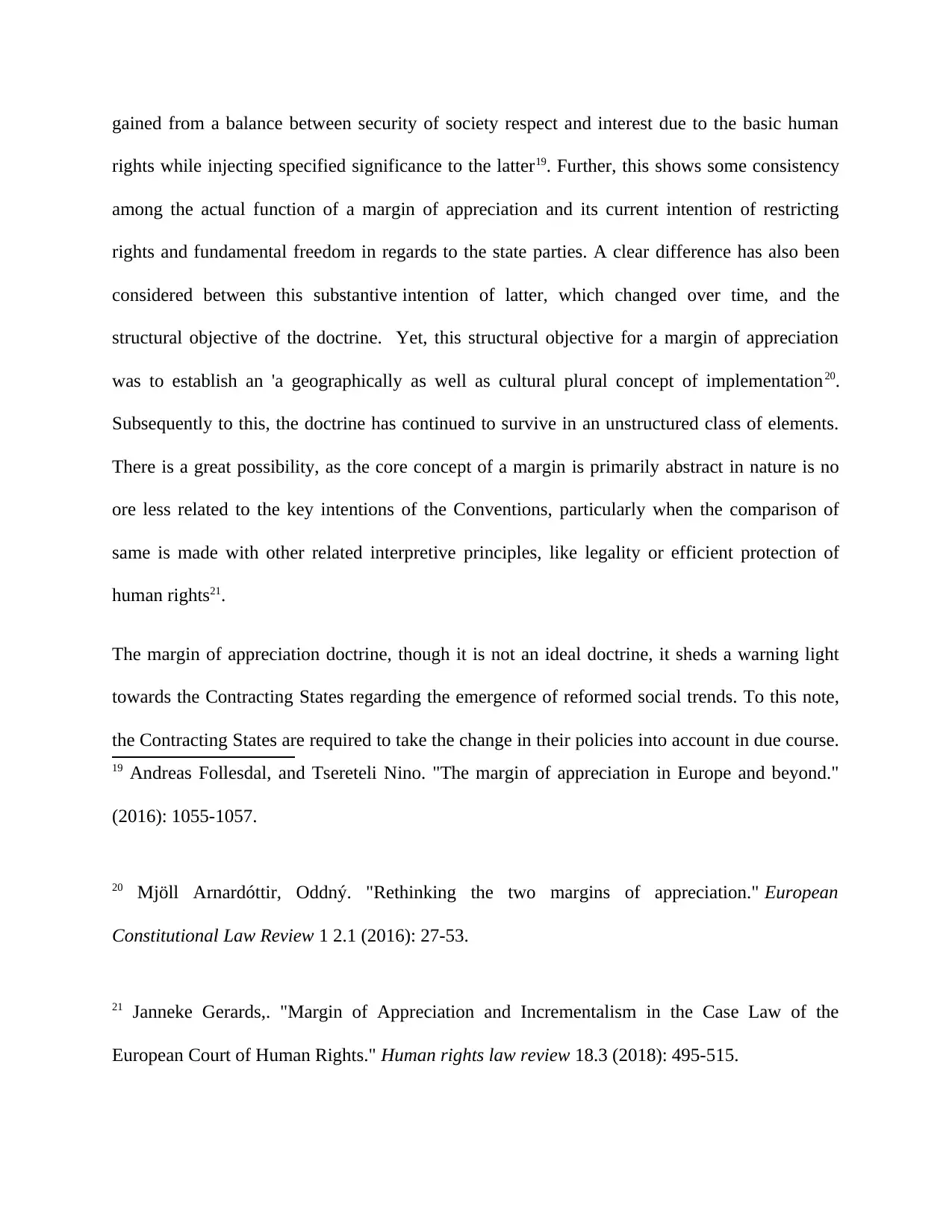
gained from a balance between security of society respect and interest due to the basic human
rights while injecting specified significance to the latter19. Further, this shows some consistency
among the actual function of a margin of appreciation and its current intention of restricting
rights and fundamental freedom in regards to the state parties. A clear difference has also been
considered between this substantive intention of latter, which changed over time, and the
structural objective of the doctrine. Yet, this structural objective for a margin of appreciation
was to establish an 'a geographically as well as cultural plural concept of implementation20.
Subsequently to this, the doctrine has continued to survive in an unstructured class of elements.
There is a great possibility, as the core concept of a margin is primarily abstract in nature is no
ore less related to the key intentions of the Conventions, particularly when the comparison of
same is made with other related interpretive principles, like legality or efficient protection of
human rights21.
The margin of appreciation doctrine, though it is not an ideal doctrine, it sheds a warning light
towards the Contracting States regarding the emergence of reformed social trends. To this note,
the Contracting States are required to take the change in their policies into account in due course.
19 Andreas Follesdal, and Tsereteli Nino. "The margin of appreciation in Europe and beyond."
(2016): 1055-1057.
20 Mjöll Arnardóttir, Oddný. "Rethinking the two margins of appreciation." European
Constitutional Law Review 1 2.1 (2016): 27-53.
21 Janneke Gerards,. "Margin of Appreciation and Incrementalism in the Case Law of the
European Court of Human Rights." Human rights law review 18.3 (2018): 495-515.
rights while injecting specified significance to the latter19. Further, this shows some consistency
among the actual function of a margin of appreciation and its current intention of restricting
rights and fundamental freedom in regards to the state parties. A clear difference has also been
considered between this substantive intention of latter, which changed over time, and the
structural objective of the doctrine. Yet, this structural objective for a margin of appreciation
was to establish an 'a geographically as well as cultural plural concept of implementation20.
Subsequently to this, the doctrine has continued to survive in an unstructured class of elements.
There is a great possibility, as the core concept of a margin is primarily abstract in nature is no
ore less related to the key intentions of the Conventions, particularly when the comparison of
same is made with other related interpretive principles, like legality or efficient protection of
human rights21.
The margin of appreciation doctrine, though it is not an ideal doctrine, it sheds a warning light
towards the Contracting States regarding the emergence of reformed social trends. To this note,
the Contracting States are required to take the change in their policies into account in due course.
19 Andreas Follesdal, and Tsereteli Nino. "The margin of appreciation in Europe and beyond."
(2016): 1055-1057.
20 Mjöll Arnardóttir, Oddný. "Rethinking the two margins of appreciation." European
Constitutional Law Review 1 2.1 (2016): 27-53.
21 Janneke Gerards,. "Margin of Appreciation and Incrementalism in the Case Law of the
European Court of Human Rights." Human rights law review 18.3 (2018): 495-515.
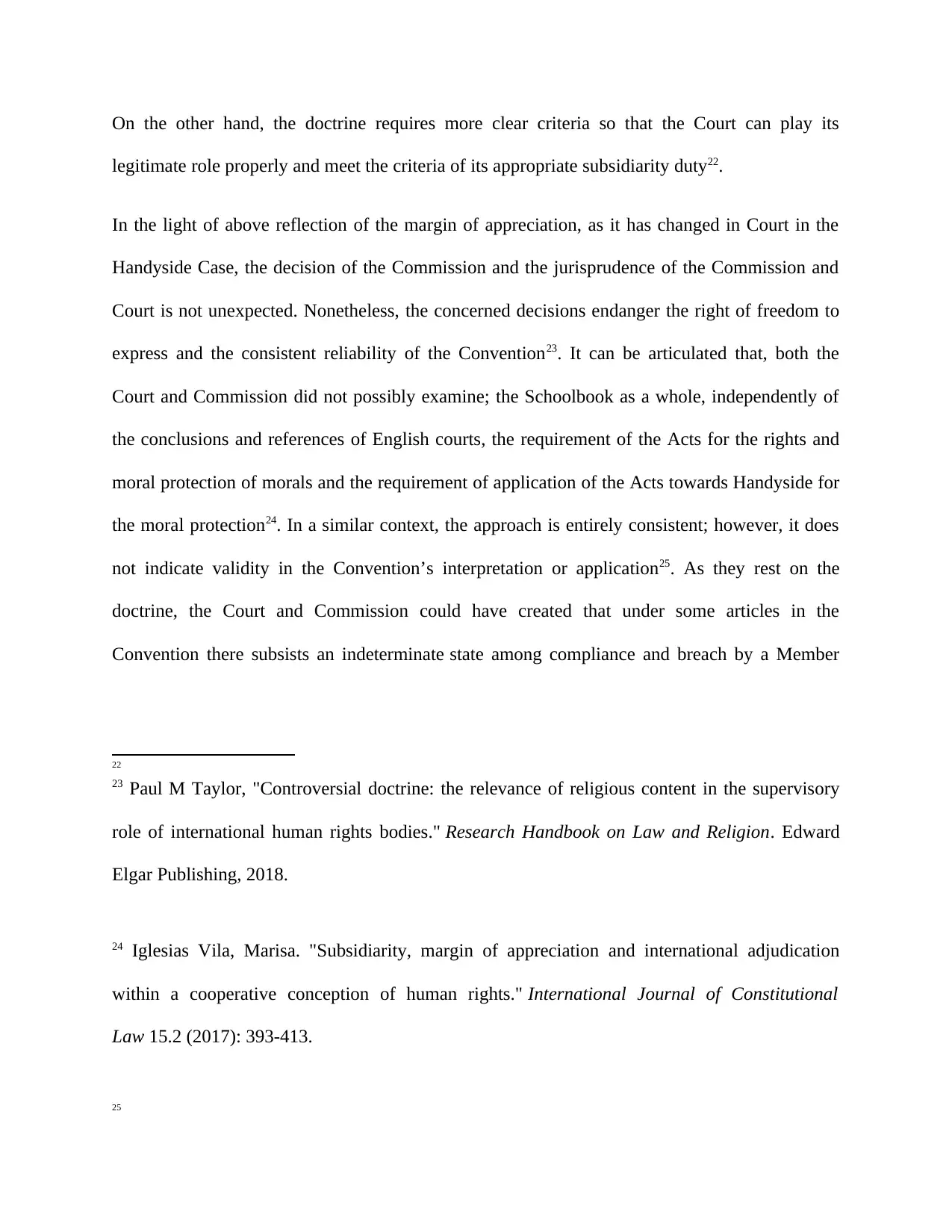
On the other hand, the doctrine requires more clear criteria so that the Court can play its
legitimate role properly and meet the criteria of its appropriate subsidiarity duty22.
In the light of above reflection of the margin of appreciation, as it has changed in Court in the
Handyside Case, the decision of the Commission and the jurisprudence of the Commission and
Court is not unexpected. Nonetheless, the concerned decisions endanger the right of freedom to
express and the consistent reliability of the Convention23. It can be articulated that, both the
Court and Commission did not possibly examine; the Schoolbook as a whole, independently of
the conclusions and references of English courts, the requirement of the Acts for the rights and
moral protection of morals and the requirement of application of the Acts towards Handyside for
the moral protection24. In a similar context, the approach is entirely consistent; however, it does
not indicate validity in the Convention’s interpretation or application25. As they rest on the
doctrine, the Court and Commission could have created that under some articles in the
Convention there subsists an indeterminate state among compliance and breach by a Member
22
23 Paul M Taylor, "Controversial doctrine: the relevance of religious content in the supervisory
role of international human rights bodies." Research Handbook on Law and Religion. Edward
Elgar Publishing, 2018.
24 Iglesias Vila, Marisa. "Subsidiarity, margin of appreciation and international adjudication
within a cooperative conception of human rights." International Journal of Constitutional
Law 15.2 (2017): 393-413.
25
legitimate role properly and meet the criteria of its appropriate subsidiarity duty22.
In the light of above reflection of the margin of appreciation, as it has changed in Court in the
Handyside Case, the decision of the Commission and the jurisprudence of the Commission and
Court is not unexpected. Nonetheless, the concerned decisions endanger the right of freedom to
express and the consistent reliability of the Convention23. It can be articulated that, both the
Court and Commission did not possibly examine; the Schoolbook as a whole, independently of
the conclusions and references of English courts, the requirement of the Acts for the rights and
moral protection of morals and the requirement of application of the Acts towards Handyside for
the moral protection24. In a similar context, the approach is entirely consistent; however, it does
not indicate validity in the Convention’s interpretation or application25. As they rest on the
doctrine, the Court and Commission could have created that under some articles in the
Convention there subsists an indeterminate state among compliance and breach by a Member
22
23 Paul M Taylor, "Controversial doctrine: the relevance of religious content in the supervisory
role of international human rights bodies." Research Handbook on Law and Religion. Edward
Elgar Publishing, 2018.
24 Iglesias Vila, Marisa. "Subsidiarity, margin of appreciation and international adjudication
within a cooperative conception of human rights." International Journal of Constitutional
Law 15.2 (2017): 393-413.
25
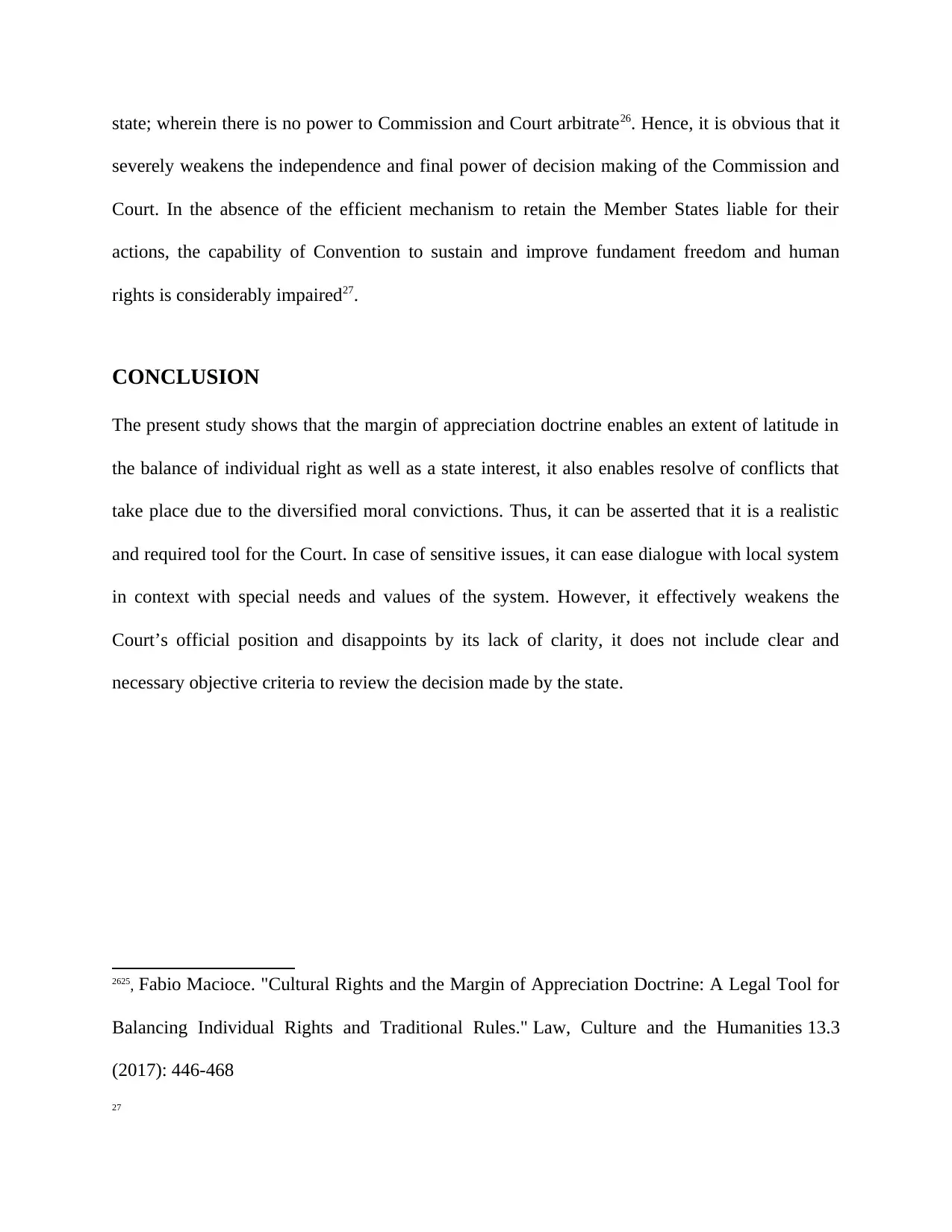
state; wherein there is no power to Commission and Court arbitrate26. Hence, it is obvious that it
severely weakens the independence and final power of decision making of the Commission and
Court. In the absence of the efficient mechanism to retain the Member States liable for their
actions, the capability of Convention to sustain and improve fundament freedom and human
rights is considerably impaired27.
CONCLUSION
The present study shows that the margin of appreciation doctrine enables an extent of latitude in
the balance of individual right as well as a state interest, it also enables resolve of conflicts that
take place due to the diversified moral convictions. Thus, it can be asserted that it is a realistic
and required tool for the Court. In case of sensitive issues, it can ease dialogue with local system
in context with special needs and values of the system. However, it effectively weakens the
Court’s official position and disappoints by its lack of clarity, it does not include clear and
necessary objective criteria to review the decision made by the state.
2625, Fabio Macioce. "Cultural Rights and the Margin of Appreciation Doctrine: A Legal Tool for
Balancing Individual Rights and Traditional Rules." Law, Culture and the Humanities 13.3
(2017): 446-468
27
severely weakens the independence and final power of decision making of the Commission and
Court. In the absence of the efficient mechanism to retain the Member States liable for their
actions, the capability of Convention to sustain and improve fundament freedom and human
rights is considerably impaired27.
CONCLUSION
The present study shows that the margin of appreciation doctrine enables an extent of latitude in
the balance of individual right as well as a state interest, it also enables resolve of conflicts that
take place due to the diversified moral convictions. Thus, it can be asserted that it is a realistic
and required tool for the Court. In case of sensitive issues, it can ease dialogue with local system
in context with special needs and values of the system. However, it effectively weakens the
Court’s official position and disappoints by its lack of clarity, it does not include clear and
necessary objective criteria to review the decision made by the state.
2625, Fabio Macioce. "Cultural Rights and the Margin of Appreciation Doctrine: A Legal Tool for
Balancing Individual Rights and Traditional Rules." Law, Culture and the Humanities 13.3
(2017): 446-468
27
Paraphrase This Document
Need a fresh take? Get an instant paraphrase of this document with our AI Paraphraser
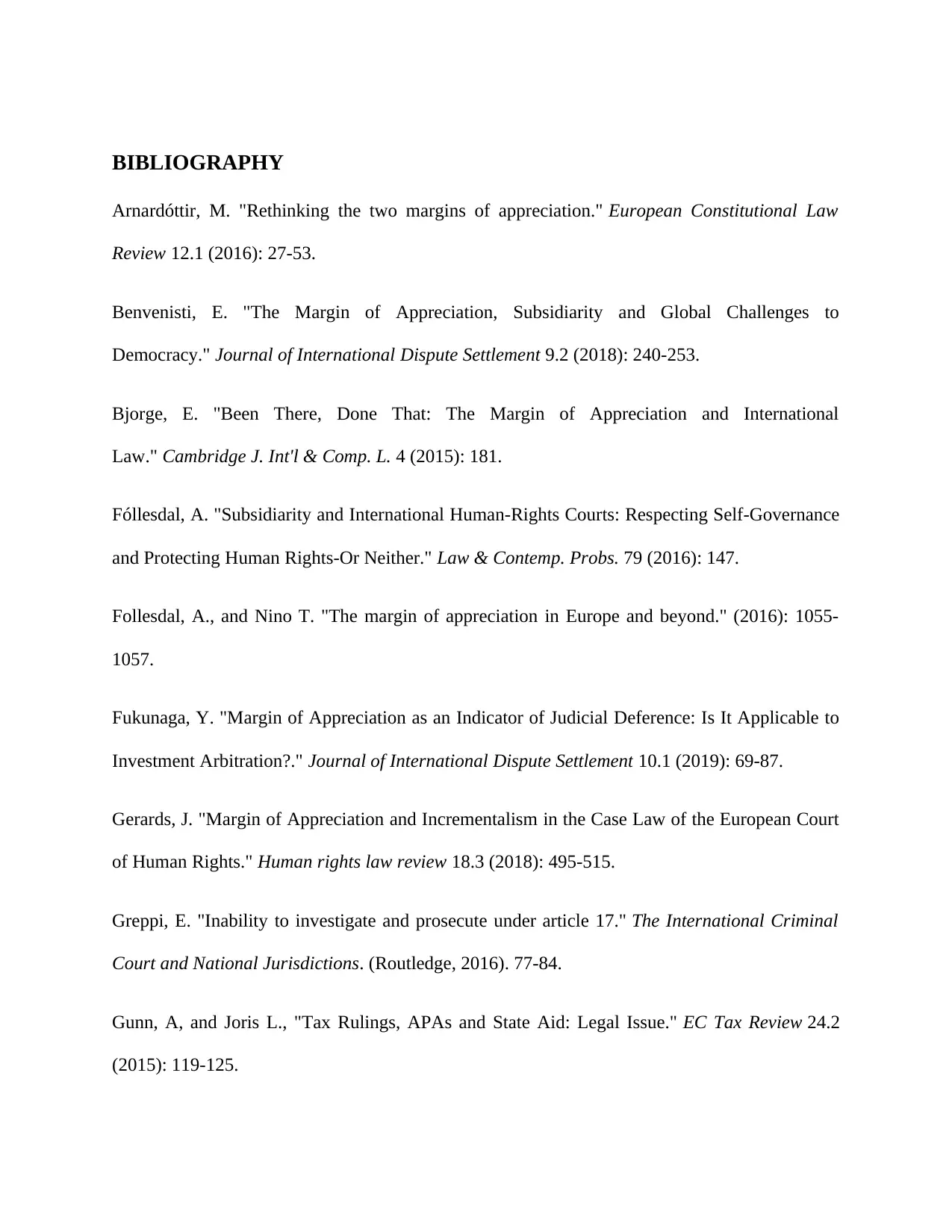
BIBLIOGRAPHY
Arnardóttir, M. "Rethinking the two margins of appreciation." European Constitutional Law
Review 12.1 (2016): 27-53.
Benvenisti, E. "The Margin of Appreciation, Subsidiarity and Global Challenges to
Democracy." Journal of International Dispute Settlement 9.2 (2018): 240-253.
Bjorge, E. "Been There, Done That: The Margin of Appreciation and International
Law." Cambridge J. Int'l & Comp. L. 4 (2015): 181.
Fóllesdal, A. "Subsidiarity and International Human-Rights Courts: Respecting Self-Governance
and Protecting Human Rights-Or Neither." Law & Contemp. Probs. 79 (2016): 147.
Follesdal, A., and Nino T. "The margin of appreciation in Europe and beyond." (2016): 1055-
1057.
Fukunaga, Y. "Margin of Appreciation as an Indicator of Judicial Deference: Is It Applicable to
Investment Arbitration?." Journal of International Dispute Settlement 10.1 (2019): 69-87.
Gerards, J. "Margin of Appreciation and Incrementalism in the Case Law of the European Court
of Human Rights." Human rights law review 18.3 (2018): 495-515.
Greppi, E. "Inability to investigate and prosecute under article 17." The International Criminal
Court and National Jurisdictions. (Routledge, 2016). 77-84.
Gunn, A, and Joris L., "Tax Rulings, APAs and State Aid: Legal Issue." EC Tax Review 24.2
(2015): 119-125.
Arnardóttir, M. "Rethinking the two margins of appreciation." European Constitutional Law
Review 12.1 (2016): 27-53.
Benvenisti, E. "The Margin of Appreciation, Subsidiarity and Global Challenges to
Democracy." Journal of International Dispute Settlement 9.2 (2018): 240-253.
Bjorge, E. "Been There, Done That: The Margin of Appreciation and International
Law." Cambridge J. Int'l & Comp. L. 4 (2015): 181.
Fóllesdal, A. "Subsidiarity and International Human-Rights Courts: Respecting Self-Governance
and Protecting Human Rights-Or Neither." Law & Contemp. Probs. 79 (2016): 147.
Follesdal, A., and Nino T. "The margin of appreciation in Europe and beyond." (2016): 1055-
1057.
Fukunaga, Y. "Margin of Appreciation as an Indicator of Judicial Deference: Is It Applicable to
Investment Arbitration?." Journal of International Dispute Settlement 10.1 (2019): 69-87.
Gerards, J. "Margin of Appreciation and Incrementalism in the Case Law of the European Court
of Human Rights." Human rights law review 18.3 (2018): 495-515.
Greppi, E. "Inability to investigate and prosecute under article 17." The International Criminal
Court and National Jurisdictions. (Routledge, 2016). 77-84.
Gunn, A, and Joris L., "Tax Rulings, APAs and State Aid: Legal Issue." EC Tax Review 24.2
(2015): 119-125.
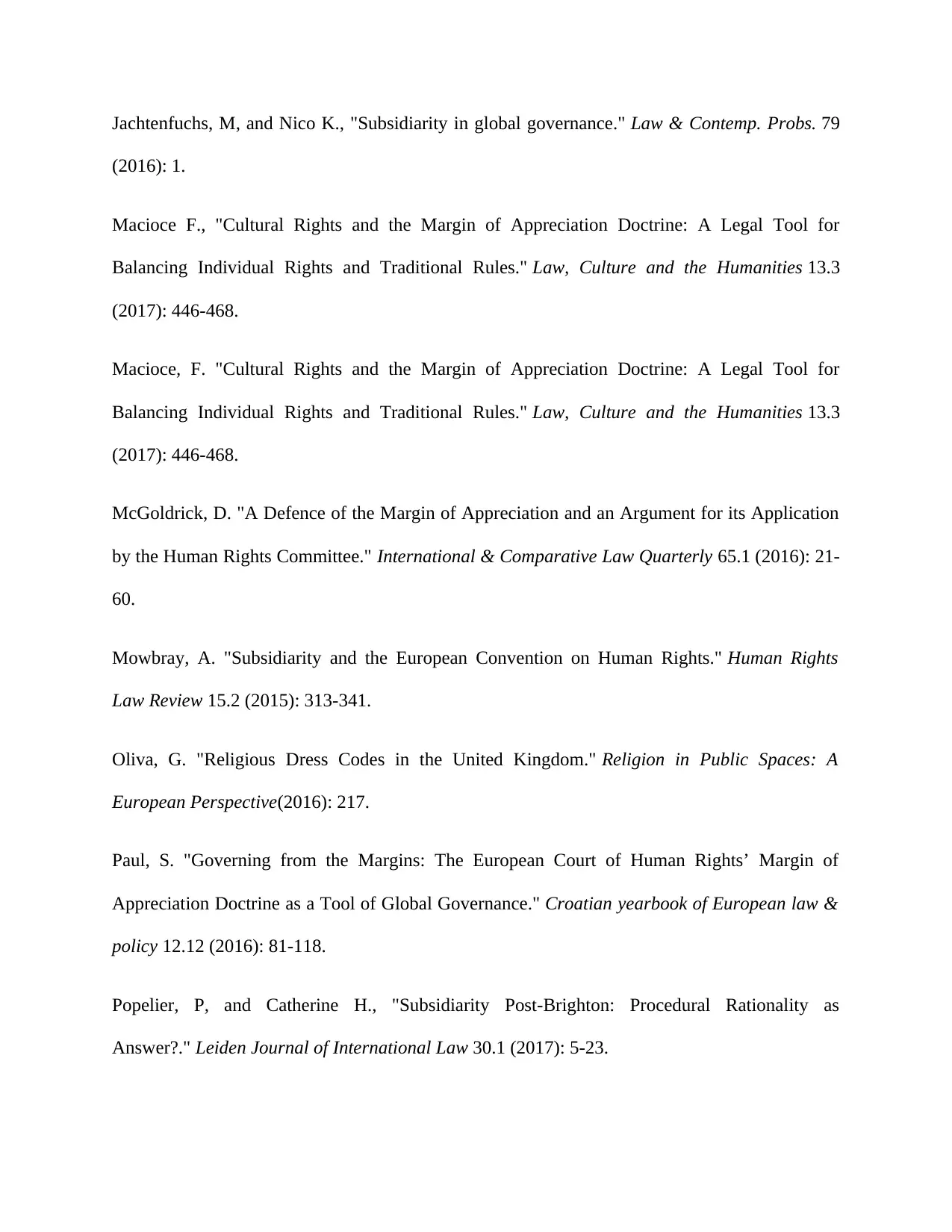
Jachtenfuchs, M, and Nico K., "Subsidiarity in global governance." Law & Contemp. Probs. 79
(2016): 1.
Macioce F., "Cultural Rights and the Margin of Appreciation Doctrine: A Legal Tool for
Balancing Individual Rights and Traditional Rules." Law, Culture and the Humanities 13.3
(2017): 446-468.
Macioce, F. "Cultural Rights and the Margin of Appreciation Doctrine: A Legal Tool for
Balancing Individual Rights and Traditional Rules." Law, Culture and the Humanities 13.3
(2017): 446-468.
McGoldrick, D. "A Defence of the Margin of Appreciation and an Argument for its Application
by the Human Rights Committee." International & Comparative Law Quarterly 65.1 (2016): 21-
60.
Mowbray, A. "Subsidiarity and the European Convention on Human Rights." Human Rights
Law Review 15.2 (2015): 313-341.
Oliva, G. "Religious Dress Codes in the United Kingdom." Religion in Public Spaces: A
European Perspective(2016): 217.
Paul, S. "Governing from the Margins: The European Court of Human Rights’ Margin of
Appreciation Doctrine as a Tool of Global Governance." Croatian yearbook of European law &
policy 12.12 (2016): 81-118.
Popelier, P, and Catherine H., "Subsidiarity Post-Brighton: Procedural Rationality as
Answer?." Leiden Journal of International Law 30.1 (2017): 5-23.
(2016): 1.
Macioce F., "Cultural Rights and the Margin of Appreciation Doctrine: A Legal Tool for
Balancing Individual Rights and Traditional Rules." Law, Culture and the Humanities 13.3
(2017): 446-468.
Macioce, F. "Cultural Rights and the Margin of Appreciation Doctrine: A Legal Tool for
Balancing Individual Rights and Traditional Rules." Law, Culture and the Humanities 13.3
(2017): 446-468.
McGoldrick, D. "A Defence of the Margin of Appreciation and an Argument for its Application
by the Human Rights Committee." International & Comparative Law Quarterly 65.1 (2016): 21-
60.
Mowbray, A. "Subsidiarity and the European Convention on Human Rights." Human Rights
Law Review 15.2 (2015): 313-341.
Oliva, G. "Religious Dress Codes in the United Kingdom." Religion in Public Spaces: A
European Perspective(2016): 217.
Paul, S. "Governing from the Margins: The European Court of Human Rights’ Margin of
Appreciation Doctrine as a Tool of Global Governance." Croatian yearbook of European law &
policy 12.12 (2016): 81-118.
Popelier, P, and Catherine H., "Subsidiarity Post-Brighton: Procedural Rationality as
Answer?." Leiden Journal of International Law 30.1 (2017): 5-23.
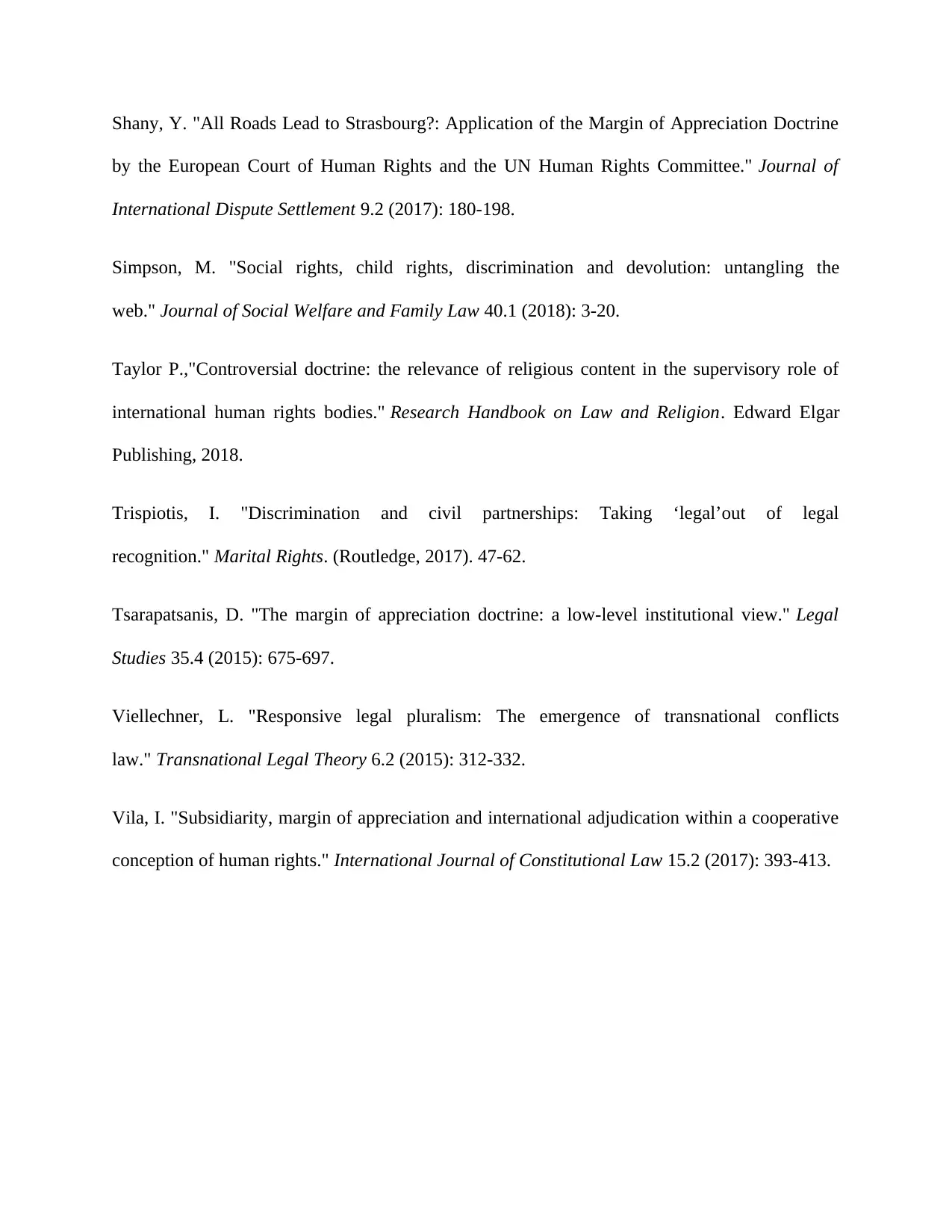
Shany, Y. "All Roads Lead to Strasbourg?: Application of the Margin of Appreciation Doctrine
by the European Court of Human Rights and the UN Human Rights Committee." Journal of
International Dispute Settlement 9.2 (2017): 180-198.
Simpson, M. "Social rights, child rights, discrimination and devolution: untangling the
web." Journal of Social Welfare and Family Law 40.1 (2018): 3-20.
Taylor P.,"Controversial doctrine: the relevance of religious content in the supervisory role of
international human rights bodies." Research Handbook on Law and Religion. Edward Elgar
Publishing, 2018.
Trispiotis, I. "Discrimination and civil partnerships: Taking ‘legal’out of legal
recognition." Marital Rights. (Routledge, 2017). 47-62.
Tsarapatsanis, D. "The margin of appreciation doctrine: a low-level institutional view." Legal
Studies 35.4 (2015): 675-697.
Viellechner, L. "Responsive legal pluralism: The emergence of transnational conflicts
law." Transnational Legal Theory 6.2 (2015): 312-332.
Vila, I. "Subsidiarity, margin of appreciation and international adjudication within a cooperative
conception of human rights." International Journal of Constitutional Law 15.2 (2017): 393-413.
by the European Court of Human Rights and the UN Human Rights Committee." Journal of
International Dispute Settlement 9.2 (2017): 180-198.
Simpson, M. "Social rights, child rights, discrimination and devolution: untangling the
web." Journal of Social Welfare and Family Law 40.1 (2018): 3-20.
Taylor P.,"Controversial doctrine: the relevance of religious content in the supervisory role of
international human rights bodies." Research Handbook on Law and Religion. Edward Elgar
Publishing, 2018.
Trispiotis, I. "Discrimination and civil partnerships: Taking ‘legal’out of legal
recognition." Marital Rights. (Routledge, 2017). 47-62.
Tsarapatsanis, D. "The margin of appreciation doctrine: a low-level institutional view." Legal
Studies 35.4 (2015): 675-697.
Viellechner, L. "Responsive legal pluralism: The emergence of transnational conflicts
law." Transnational Legal Theory 6.2 (2015): 312-332.
Vila, I. "Subsidiarity, margin of appreciation and international adjudication within a cooperative
conception of human rights." International Journal of Constitutional Law 15.2 (2017): 393-413.
1 out of 16
Related Documents
Your All-in-One AI-Powered Toolkit for Academic Success.
+13062052269
info@desklib.com
Available 24*7 on WhatsApp / Email
![[object Object]](/_next/static/media/star-bottom.7253800d.svg)
Unlock your academic potential
© 2024 | Zucol Services PVT LTD | All rights reserved.





